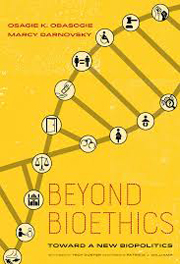Review - Beyond Bioethics: Toward a New Biopolitics
By Jordan Liz,
Metapsychology Online Reviews [Review of the book edited by CGS' Osagie K Obasogie and Marcy Darnovsky]
| 09. 04. 2018
From the successful cloning of Dolly the sheep, to the FDA's approval of BiDil as the first race-specific medication to ongoing discussions concerning the use of gene editing technologies such as "CRISPR," medical innovations during the past couple of decades have raised a number of significant ethical, social and political questions. Should cloning as human reproduction be limited? Is the pursuit of race-based medicine morally acceptable? Would it be a moral failure to abstain from using gene-editing technologies if they are proven safe to use? For Osagie K. Obasogie and Marcy Darnovsky, the editors of Beyond Biopolitics: Toward a New Bioethics, these questions are further complicated by the specific sociopolitical context in which they arise. How do we understand, for instance, the FDA's approval of BiDil alongside the history of race and eugenics in the United States? Addressing these questions requires, on their account, a conceptual framework and approach not found in contemporary bioethics.
To elaborate, for Obasogie and Darnovsky, bioethics currently operates on the basis of principlism. Principlism "provides a common framework by embracing four principles as...
Related Articles
A Review of Exposed by Becky McClain
“Do not get lost in a sea of despair. Be hopeful, be optimistic. Our struggle is not the struggle of a day, a week, a month, or a year, it is the struggle of a lifetime. Never, ever be afraid to make some noise and get in good trouble, necessary trouble.”
— John Lewis
Becky McClain became famous when she successfully sued Pfizer, one of the very largest pharmaceutical and biotech companies. She...
By Josie Ensor, The Times | 12.09.2025
A fertility start-up that promises to screen embryos to give would-be parents their “best baby” has come under fire for a “misuse of science”.
Nucleus Genomics describes its mission as “IVF for genetic optimisation”, offering advanced embryo testing that allows...
By Katherine Long, Ben Foldy, and Lingling Wei, The Wall Street Journal | 12.13.2025
Inside a closed Los Angeles courtroom, something wasn’t right.
Clerks working for family court Judge Amy Pellman were reviewing routine surrogacy petitions when they spotted an unusual pattern: the same name, again and again.
A Chinese billionaire was seeking parental...
By Tina Stevens, CounterPunch | 12.11.2025
Silicon Valley and other high tech billionaires are investing millions in start-ups dedicated to creating genetically engineered (GE) babies, according to a recent Wall Street Journal (WSJ) report. AI mogul Sam Altman, cryptocurrency entrepreneur Brian Armstrong, venture capitalist Peter...




